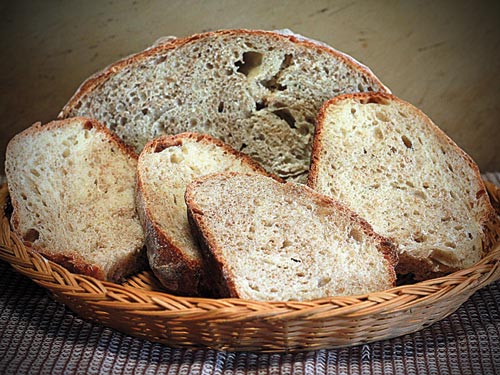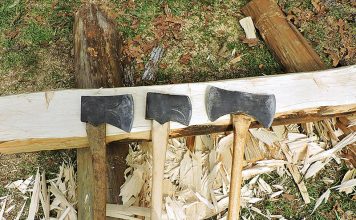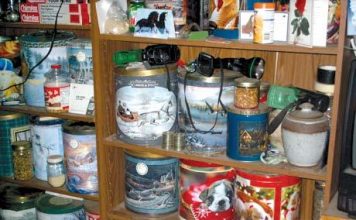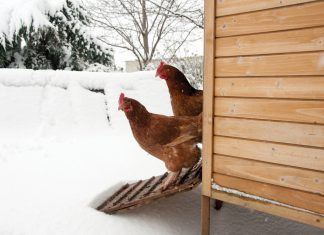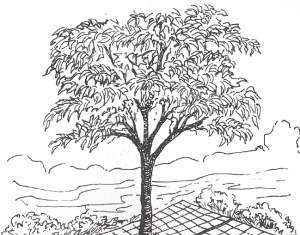 |
|
| Issue #141 • May/June, 2013 |
Rye has been a popular bread grain in many parts of Europe for hundreds of years, second only to wheat. Popular regional rye breads can be found in Russia, Germany, Poland, the Czech Republic, Austria, Italy, and France. In spite of the large number of Americans whose ancestors emigrated here from those countries, breads made with rye are not as popular here as they are in Europe. This is unfortunate because a properly-made loaf of rye, containing a balanced combination of rye and wheat flour, or all rye flour, will emerge from the oven with a unique aroma that only rye can contribute.
Rye has a distinct flavor, and produces a loaf of bread with “crumb” (texture of the inner loaf) that is a little more dense than wheat. By varying the amount of rye flour in the formula, and extending fermentation, you can customize this bread to your personal preference. An excellent loaf of rye bread can be made with only 12 percent rye flour, a fermented wheat-flour starter, a pinch of commercial yeast, salt, and water. The result will be a loaf with stunning flavor, texture, and good keeping quality. As more rye flour is incorporated into the dough, the finished bread will develop more flavor and texture.
Sadly, very few bakeries in this country produce rye bread. Of the few that do, most fake it by combining a high volume of wheat flour with a small amount of white rye flour, which has very little flavor. This mass-produced bread is usually leavened with a high percentage of commercial yeast to save time. When made properly, a loaf of rye bread contains a certain amount of natural acidity, usually provided by some form of fermented flour starter. I will cover this in more detail later.
Commercial rye bread is usually mixed, proofed, baked, packaged, and shipped to the stores the same day. This type of hasty production results in bread with a marshmallow-like texture and very little flavor. Any flavor these loaves may have is often the by-product of incorporating excessive amounts of caraway seeds into the mix, along with concentrates of lactic and/or acetic acids to mimic the taste of natural sourdough. The overuse of these ingredients completely masks the clean, robust flavor of the rye flour and often insults the palate with an overly-sour and potent caraway flavor.

Caraway rye bread
Unless you are fortunate enough to have a relative, friend, or neighbor with roots in one of the Eastern or Northern European countries, with a talent and love for baking bread, your experience with rye bread is probably limited to these fake commercial loaves. It is important to understand that properly-made rye bread has a firm but light texture, and a robust balanced flavor that can be further enhanced with the addition of toasted nuts, seeds, dried fruits, and a variety of whole herbs and spices, including caraway, in moderate amounts.
If you are one of a vast majority in this country to whom the robust flavor and bold texture of Old World rye bread may be a little out of your comfort zone, take heart. By using some simple basic techniques developed by master bakers, along with the modifications that I have added to the formulas presented here, you can take maximum advantage of the unique characteristics to rye flour and successfully bake this wonderful bread in your own kitchen, customizing the loaf to your personal taste. You do not have to live next to an artisan bakery or order an expensive frozen loaf from an online bakery to discover the joys of Old World rye bread. All you need is a good formula, a little patience, and some basic baking equipment and supplies.
I grew up in a Boston neighborhood where home-baked whole-grain breads were common in many households. My mother’s favorites were the rye breads with roots in Eastern and Northern Europe. These breads were usually made with a high percentage of rye flour (70 percent or more) and were leavened with a rye sourdough starter and no commercial yeast.
My mother’s fascination with these breads began when a neighbor gave her a small piece of raw bread dough wrapped in waxed paper. She told my mother that it was a piece of dough saved from a loaf of rye that she had made the day before. She taught my mother how to assemble, mix, proof, and bake a loaf of the same bread using this “old dough,” as she called it. On another occasion, this neighbor gave my mother a small glass bowl with about one-half cup of what she called, “Old World rye sourdough mother culture.” She advised my mother to use this old dough soon, because it contained fresh baking yeast that would only remain active for another day. The rye mother culture, she said, would be fine if she kept it in a refrigerator. She came back a few days later with a recipe for a caraway rye bread containing 40 percent rye flour. She taught my mother how to prepare this loaf using the rye mother culture. The loaf made with the old dough contained only 15 percent dark rye flour, but had plenty of rye flavor and texture, making it a great all-purpose bread for sandwiches and toast.
My mother fell in love with this bread after her first bite, and it soon became a standard in our house. On holidays and special occasions she would often increase the amount of rye flour in the recipe and add dried fruit, nuts, and spices. With these additions she transformed this basic sandwich bread into one that could be sliced and eaten with little embellishment, except for a small amount of smoked salmon or sharp cheese. This same neighbor also taught my mother how to prepare and bake with an all-rye flour sourdough starter.
Sadly, I hadn’t given much thought to this wonderful bread of my youth for several years until reading a short article in the weekly food section of my local newspaper. The article outlined the differences between the mass-produced rye breads sold in supermarkets and traditional Old World rye breads of Eastern and Northern Europe. The article inspired me to once again dig into my mother’s mountain of old recipes until I found her long-forgotten sourdough rye bread formula. We will be working with an updated version of this proven formula when we get to the recipe section.
After a long absence from baking breads made with rye flour, I quickly discovered that I had forgotten many of the distinct differences between it and wheat flour. As a result, the first loaves that I baked, using my mother’s recipe, were dense, pasty, and lifeless. After repairing my damaged ego, I called my baker friend Mike, and asked his advice on how to proceed.
He reinforced my suspicion that rye flour has some unique characteristics that must be taken into consideration when incorporated into any bread formula. He suggested that I read selected works of a couple of master bakers with extensive knowledge and experience working with rye flour. I spent six months reading articles and books written by these bakers. As a result of their genius, and my mom’s old recipe, I was able to assemble and successfully bake about 60 wonderful loaves of rye using varying amounts of rye flour. The most important thing this effort taught me was to park most of my experience baking with wheat flour at the door when I enter the kitchen to bake rye bread.

Equipment and supplies for making rye bread: KitchenAid stand mixer, King Arthur bread flour, Bob’s Red Mill Dark Rye Flour, 3 packs of instant yeast, nonstick cooling rack, silicone spatula, instant read thermometer, cast iron Dutch oven, stainless steel bowl for final proofing, pot holder, plastic and stainless bench scrapers, digital scale, straight edge razor, stainless measuring spoons, sewing scissors, parchment paper, stainless measuring cups.
There are several distinct differences between rye and wheat flour. Understanding these differences and embracing some different but simple flour-handling techniques will consistently produce rye bread with great flavor, a moist and tender crumb, and excellent keeping quality.
Before we look at some of the differences, I would like to offer you a bit of advice: Please don’t let the following facts about rye flour, and how it differs from wheat flour in bread baking, discourage you from adding rye bread to your baking schedule. Successful techniques for working with rye flour have been developed and implemented by professional bakers. As you read on, you will discover that mixing, fermenting, proofing, and baking a successful loaf of rye bread does take a little more time but far less effort than preparing a loaf of wheat bread. For example, tiresome kneading is greatly minimized, or eliminated, from bread formulas containing rye flour. If you give the dough enough time, it will do most of the work for you.
Rye bread represents an area of great potential for anyone willing to take time to understand the very special production requirements that are necessary when baking with rye flour. Excellent rye breads can contain from a minimum of 12 percent rye, combined with whole wheat or other specialty flours, and up to 100 percent rye flour, to make an endless variety of breads with interesting flavors and textures.
Adding rye flour to a bread formula changes how the dough is mixed, fermented, proofed, baked, and eaten. Like wheat, rye flour contains gluten, the protein that provides structure to bread dough. This structure is referred to as the gluten network, which makes it possible for the dough to capture carbon dioxide gas produced during yeast fermentation and which causes the bread to rise during the proofing and baking. Cutting into a loaf of artisan French bread and comparing the crumb to that of a loaf of commercial white bread will reveal how different baking procedures can affect the texture of a loaf of bread.
Since rye flour contains considerably less gluten than wheat flour, it will not form a strong gluten structure similar to wheat’s. As a result, rye bread will always have a structure that is more dense than wheat bread. Rye flour also contains more bran, fiber, and minerals than wheat and because of that it will absorb more water. This extra water will potentially produce bread with a pasty crumb unless care is taken by the baker.
The high bran content in rye flour also contributes to lower volume in the finished bread. The bran pieces act like razors, cutting the gluten network and allowing some of the volume-producing gas to escape. Rye also has a higher percentage of fermentable sugars than wheat which can cause a loaf to quickly over-ferment and collapse. A high percentage of a polysaccharide (called pentosan) also causes rye flour to absorb extra water. This complex sugar competes with the gluten in the flour for moisture. Pentosans are fragile and can break down if the dough is not gently mixed. This breakdown will result in bread with a sticky and pasty crumb.
Finally, rye flour is loaded with amylase enzymes. The main function of this enzyme is to convert starch into sugar. As the loaf bakes, and the internal temperature reaches about 125º F, the starches in the rye begin to absorb water and swell to form the crumb. At this temperature the amylases are also in an active state of converting starch to sugar. Sugar does not contribute to crumb formation. These enzymes will not be destroyed until the internal temperature of the loaf reaches about 176º F. This will result in a gummy and pasty crumb unless the baker has adopted procedures to avoid it. Professional bakers call this a “starch attack.” Wheat flour doesn’t have this problem for two reasons: it doesn’t have as many amylase enzymes as rye, and wheat starch gelatinizes at a much higher temperature. To inhibit the decomposing effects of amylase enzymes in their rye loaves, professional bakers use an essential tool. Depending on just how it was developed, this vital ingredient goes by several names: sourdough seed culture, pre-ferment, poolish, and biga, to name a few. What all of these cultures have in common is their ability to develop lactic and acetic acids, wild yeasts, and bacteria that are beneficial to bread, especially rye bread. The lactic and acetic acids limit the decomposing activity of amylase enzymes, and produce a loaf with a more stable crumb. The wild yeasts and beneficial bacteria add more volume and flavor to the finished loaf.
A pure sourdough culture is simply a mixture of flour and water that has initially been aged at room temperature, under controlled and monitored conditions, until the development of wild yeasts, lactic and acetic acids, and beneficial bacteria become well established. The active seed culture is then stored under refrigeration and kept healthy with regular feedings of flour and water. A properly maintained sourdough seed culture will live longer than the baker who created it. Cultivating and baking with a homegrown sourdough is an effort that requires consistency in the use of time and temperature management.
I bake a variety of breads using sourdough cultures and yeasted pre-ferments. For the bread formulas we will be preparing here, we will be using the same pre-fermented, “old dough” starter that my mother used for many years to leaven her rye bread. This starter incorporates a tiny amount of commercial yeast mixed with some wheat flour, salt, and water.
After the initial mixing, the dough is covered and allowed to ferment for 12 to 16 hours. This extended fermentation increases the number of yeast cells in the starter, and supports the development of lactic and acetic acids, and flavor-producing beneficial bacteria. The final dough is mixed with a little more yeast, water, and salt along with a mixture of dark rye flour and wheat bread flour. The dough is allowed to ferment, in bulk, for about 2½ to 3 hours. Finally, it is shaped and proofed for about another hour before baking. As you can see, the most important resource here is time management. When you step into the kitchen to bake any of these breads, plan on the bread coming out of the oven in about 24 hours. Using a yeasted pre-ferment is not intended to be a substitute for a mature sourdough seed culture for producing a first class loaf of rye bread.
In comparison, a pure sourdough culture adds more flavor, and extends keeping quality of the bread. But these pure cultures require ongoing maintenance to keep them fresh and active. A yeasted pre-ferment also adds flavor and extended keeping-quality to a loaf. However, there are some practical reasons for the casual baker to use a pre-ferment when baking light- and medium-textured rye breads. All of a prepared pre-ferment is incorporated into the final dough. Also, a pre-ferment takes the same amount of time to develop as it does to refresh a pure sourdough culture. The small amount of commercial yeast used in the pre-ferment formula adds extra lift and lighter crumb to the finished loaf. If you are interested in developing a rye or wheat flour sourdough seed culture, I will be glad to cover the subject in another article.

Final proof in plastic bowls
Equipment and supplies
To bake any of the breads that I offer here, you need only five basic ingredients: rye flour, wheat bread flour, salt, water, and instant dried yeast. To this basic set of ingredients you can add dried fruits, roasted nuts, aromatic spices, and a wide variety of whole grains and seeds.
The definition for rye flour, as it is sold in this country, can be (and often is) confusing. The most visible distributers of rye flour to home bakers are: King Arthur Flour, Bob’s Red Mill, Hodgson Mill, and Arrowhead Mills. The rye products of these distributors can be purchased online or in your local supermarket. I have baked bread using rye flour from all of these companies with good results. However, the flour descriptions on the bags can be misleading, depending on which brand of rye flour you buy. For example, King Arthur distributes medium rye flour that has the germ and some of the bran sifted out, and is ground fine. Bob’s Red Mill distributes flour labeled Dark Rye that is also ground fine. It is very difficult for an untrained eye to determine any difference between the two flours. Both flours produced bread of similar taste and texture. Hodgson Mill distributes flour labeled Stone Ground Rye. The only difference that I could detect between this flour and Bob’s Dark Rye flour is the Hodgson Mill flour is a coarser grind. The coarse grind of this flour produces a loaf that is a little denser than a loaf made with the fine-ground flour.
When I first started this project, I rotated between all of the different rye flour brands that were available to me, hoping to find the one that produced the best and most consistent loaf. Unfortunately, this made it impossible for me to determine the cause of a problem when a loaf didn’t bake up as I expected. To solve this problem I decided to use only one rye flour for all of my baking. The Dark Rye flour sold by Bob’s Red Mill proved to suit my needs for several reasons: it is available in all of the supermarkets in my area, it is packaged in two-pound bags, which can be used in a couple of weeks (like any whole grain flour, rye will spoil if kept too long), and it is a fine-ground flour that yields the best results with my recipes. I paired this flour with King Arthur’s standard unbleached, high-gluten bread flour to add lift and structure to the loaf. Both of these flours are sold in most supermarkets and are usually fresh. Fresh flour is essential when baking rye bread. Old or stale rye flour can produce a loaf with off, and sometimes rancid, flavors.
The flour of choice for the breads I present here is the dark rye flour. The milling process for this flour includes most of the outer portion of the endosperm. The additional bran gives this flour a darker color. (See sidebar for other rye flours.)
Listed below is some basic equipment that will help make your rye-baking experience more enjoyable:
1. A sturdy electric mixer. I have a KitchenAid stand mixer that I use for all mixing functions. Powerful mixers like this can be a little pricey but, if you like to bake bread, owning one of these mixers is a wise investment. My KitchenAid is 25 years old and is still running strong.
2. A 10-inch cast iron Dutch oven. I believe that every kitchen should have one of these. Dutch ovens are almost indestructible and are available with ceramic coating for cooking everything from breads to soups and stews. To bake the breads offered here, I suggest a pre-seasoned Lodge brand Dutch oven. They are available at Amazon or Walmart for less than $30.
3. A plastic or metal blade bench scraper. Rye dough tends to be a little sticky. A bench scraper is a great tool for efficient cleanup.
4. At least two silicone spatulas with 2½-inch-wide blades. These are indispensable for scraping sticky bread dough from the mixer or other bowl. The silicone blades are also heat resistant.
5. An instant-read food thermometer that will record temperatures above 210° F. These thermometers are a must for determining just when a loaf of bread is ready to be removed from the oven. You can buy one from any store that sells kitchen equipment. A good one that will record temperatures from -40° F to over 300° F will cost as little as $20.
6. A roll of silicone parchment paper. This paper becomes non-stick when it reaches 160° F. I use it to line the bowl for the final proofing of bread dough. When I am ready to bake the loaf, this paper makes transferring the loaf to the Dutch oven painless and prevents the loaf from sticking to the pot.
7. One or two 9-inch plastic or stainless steel bowls to hold the dough for final proofing.
8. A straightedge razor blade or pair of sharp sewing scissors for making cuts in the dough before baking.
9. A nonstick cooling rack.
10. A pair of high-quality pot holders or oven mitts. Since you will be cooking your bread in a Dutch oven at a temperature of about 500° F, protection against burns is necessary.
11. A digital food scale for weighing ingredients like flour and water. Scooping flour and eyeballing the correct level of water, even in a container designed for liquid measure, isn’t accurate enough for a baker looking for consistency. Often even small variations in flour or water can result in loaves that lack consistency. Bread baking demands that the baker measure accurately. For the formulas that are presented here, flour and water require accurate measurement. A digital scale is a must for accurate measurement.
12. A good set of plastic or stainless steel measuring spoons. I own two very accurate sets of measuring spoons: a stainless steel set manufactured by Cuisipro that I bought for $12, and a set of plastic spoons manufactured by OXO Good Grips that cost only $6. Both sets measure accurately, but I prefer the stainless steel for durability.
The formulas
The breads featured in this section do not contain a lot of rye flour. However, due to the unique flavoring quality of rye, all of these breads have a very recognizable rye taste, and a firm but light crumb.
Each formula produces a high volume of pre-fermented flour starter that contains a small percentage of commercial yeast. This starter is subjected to a long fermentation that develops the mild acids, wild yeast, and beneficial bacteria that minimize problems with the rye flour and add flavor and volume to the loaf. The total amount of flour, yeast, and salt remains consistent for all three formulas. The flour proportions are adjusted as the amount of rye flour increases. In the formula with Walnuts and cranberries I have increased the amount of water to 11½ ounces to compensate for the increased amount of rye flour. The preparation method for the three formulas is also consistent and will only be outlined with the Rustic country bread. So, for the last two recipes, return to the preparation method for this recipe because, except for the inclusion of other ingredients (such as the cranberries and walnuts in the third recipe), the baking method is the same.
At last! It is time to bake. Let’s have some fun.
In each of the three recipes, I’ve listed all of the ingredients under the heading “overall formula,” so you know what ingredients to assemble before you start. Some of the ingredients will go into the “pre-ferment,” some into the “final dough,” and some will go into both.

Rustic country rye bread
Rustic country bread with 12 percent rye flour
Overall formula
14 oz. wheat bread flour
2 oz. dark rye flour
11 oz. water
2½ tsp. salt
3/8 tsp. instant yeast
Pre-ferment
8 oz. wheat bread flour
1/8 tsp. instant yeast
1 tsp. salt
5 oz. water
Final dough
6 oz. wheat bread flour
2 oz. dark rye flour
¼ tsp. instant yeast
1½ tsp. salt
6 oz. water
All of the pre-ferment
Method:
Pre-ferment: Combine the bread flour, instant yeast, and salt in a small bowl and stir to combine. Add the water and mix until the dough is just smooth and all of the flour is incorporated into the dough. Cover the bowl with plastic wrap; let it stand at about 70° F for 12 to 16 hours. When the pre-ferment is ready to use it will be domed and just beginning to collapse or dent down in the center.
Mixing the final dough: Add all ingredients to the mixer except the pre-ferment. With the dough hook attached, mix the dough for three minutes on the first speed on a KitchenAid, or low on another mixer, to blend all of the ingredients. As the dough is coming together, add the pre-ferment in chunks. If the dough seems dry, add water in very small amounts to correct the hydration.
(If this is your first effort preparing bread like this, I suggest that you resist making any changes in the formula at this time. After sampling the first slice of the finished bread you can make note of any adjustments, and incorporate them into the next loaf.)
Finish the mixing on the second speed if using a KitchenAid mixer, or medium speed for other mixers, for about 2½ minutes. Take care to maintain the mixing times that I have established. Overmixing rye flour, or mixing it too vigorously, will result in the problems, such as sticky, pasty crumb, that I outlined above.
Bulk fermentation and folding: After mixing is complete, the dough will be transferred to a suitable-size bowl that has been sprayed with a nonstick spray (like Pam), covered, and allowed to ferment for 2½ hours. During this time the dough must be folded twice. What is folding and how is it done? Due to the delicate nature of bread dough that contains rye flour, traditional kneading is not an effective way of developing a gluten structure in the dough. Depending on the amount of rye flour the dough contains, kneading it goes from difficult to impossible because rye flour makes the dough sticky. Folding is the answer to this problem, at least in these formulas. But as the amount of rye flour increases, even folding becomes impossible and unnecessary.
How do we fold dough?
1. Flour the work surface, using enough flour to prevent the dough from sticking to the counter.
2. Turn the dough out of the bowl onto the counter.
3. Gently lift about a third of the dough from the right or left side of the bulk and bring it to the middle. Pat it down so that it holds its place. Brush off any excess flour from the fold.
4. Repeat this procedure on the opposite side of the dough.
5. Now reach over and lift a third of the dough from the far side in front of you. Once again, brush any excess flour to avoid incorporating it into the dough before patting into the bulk. Repeat this with the third of dough closest to you.
6. Folding is complete. Gently lift the dough from the counter and place it back into the bowl with the folds on the bottom.
During bulk fermentation, the dough will be folded twice at 50-minute intervals.
Final fermentation: Line a 9-inch bowl with two 17-inch pieces of silicone parchment paper. One piece will be placed from right to left and the other from front to back. When it is time to bake, the bread will be lifted into the Dutch oven, along with the parchment paper, which will prevent the bread from sticking while it bakes. Cover the bowl with plastic wrap and ferment it for 1¼ to 1½ hours at about 70° F.
Baking and cooling: When the final fermentation is complete, remove the plastic wrap from the bowl. Make a six-inch slash about ½ inch deep with a new single-edge razor blade in the center of the dough and dust the dough with a little bread flour.
If a razor doesn’t produce the desired cut, a small pair of sharp sewing scissors can be substituted. Simply open the scissor blades, when you are ready to cut, then poke the lower blade about ¾ of an inch into the dough and start cutting, moving the scissors forward with each cut.
We will start baking this bread in a cold oven with the Dutch oven lid in place. The trapped steam created with this method will add volume to the finished loaf. We will finish the loaf with lid removed to promote browning.
So, lift the dough, using the parchment paper, and carefully place it into the Dutch oven and cover with the lid. Place the Dutch oven on an oven rack in the lower-middle position of the cold oven. Heat the oven to 425° F. Once that oven temperature has been reached, continue baking the bread for 30 minutes.
Carefully remove the lid and continue to bake another 15 minutes. Now, insert the thermometer into the bread and bake the bread until it reaches an internal temperature of 210° F.
Carefully remove the Dutch oven from your oven and place on the stove top. Remove the bread from the pot and place on a wire rack. Cool the bread to room temperature, about two hours.
This method is the same method you’ll use in the next two recipes.

Walnut and cranberry rye bread
Light rye with 22 percent rye flour with caraway seed
Types of rye flour
If you decide that home-baked rye bread suits your tastes, we can discuss how to use the other rye products at another time. Here is a list of other rye grain products usually available in supermarkets or specialty food stores.
White rye flour. This flour is milled from the very center of the rye endosperm. Most of the bran and germ are removed during the milling process. This flour is almost white and has very little rye flavor.
Medium rye flour. This flour is the milled from the entire endosperm of the grain along with some of the bran and fiber from the outer portion of the endosperm.
Whole rye/pumpernickel flour. This flour is the whole rye berry that has been coarsely milled.
Rye flakes are the whole rye berries that are usually steamed to soften them, then rolled into flakes that resemble old-fashioned oatmeal, and can be cooked like old-fashioned oatmeal. Add some fruit and a little yogurt for an interesting and healthful breakfast.
Rye chops are whole rye berries that are chopped and resemble steel cut oats or buckwheat. This type of rye can also be cooked like steel cut oats and eaten for breakfast.
Rye berries are whole rye grain that has not been milled. Like wheat berries, rye berries must be cooked before adding them to a bread formula.
Overall formula
12½ oz. bread flour
3½ oz. dark rye flour
11 oz. water
3/8 tsp. instant yeast
2½ tsp. salt
2 tsp. caraway seed, lightly toasted in a small skillet and set it aside to cool before adding it to the dough
Pre-ferment
8 oz. bread flour
5 oz. water
1 tsp. salt
1/8 tsp. instant yeast
Final dough
4½ oz. bread flour
3½ oz. dark rye flour
2 tsp. toasted caraway seed
1½ tsp. salt
¼ tsp. instant yeast
6 oz. water
All of the pre-ferment
Method:
To bake, use the method from the first recipe.
Walnut and cranberry with 30 percent rye
Overall formula
11¼ oz. high-gluten bread flour
4¾ oz. dark rye flour
11½ oz. water
2½ tsp. salt
3/8 tsp. instant yeast
2 oz. dried cranberries
2 oz. walnuts, coarsely chopped and lightly toasted
Pre-ferment
8 oz. high-gluten bread flour
5 oz. water
1 tsp. salt
1/8 tsp. instant yeast
Final dough
3¼ oz. high-gluten bread flour
4¾ oz. dark rye flour
6½ oz. water
1½ tsp. salt
1/8 tsp. instant yeast
2 oz. dried cranberries
2 oz. walnuts, coarsely chopped and lightly toasted
Method:
Use the method for the first recipe except add the cranberries and walnuts to the dough in the final minute of mixing. After that, continue to use the method from the first recipe.
I hope I have given you enough meaningful insight into the often misunderstood and often ignored world of rye berry. Please give these formulas a try. You will not be disappointed.


